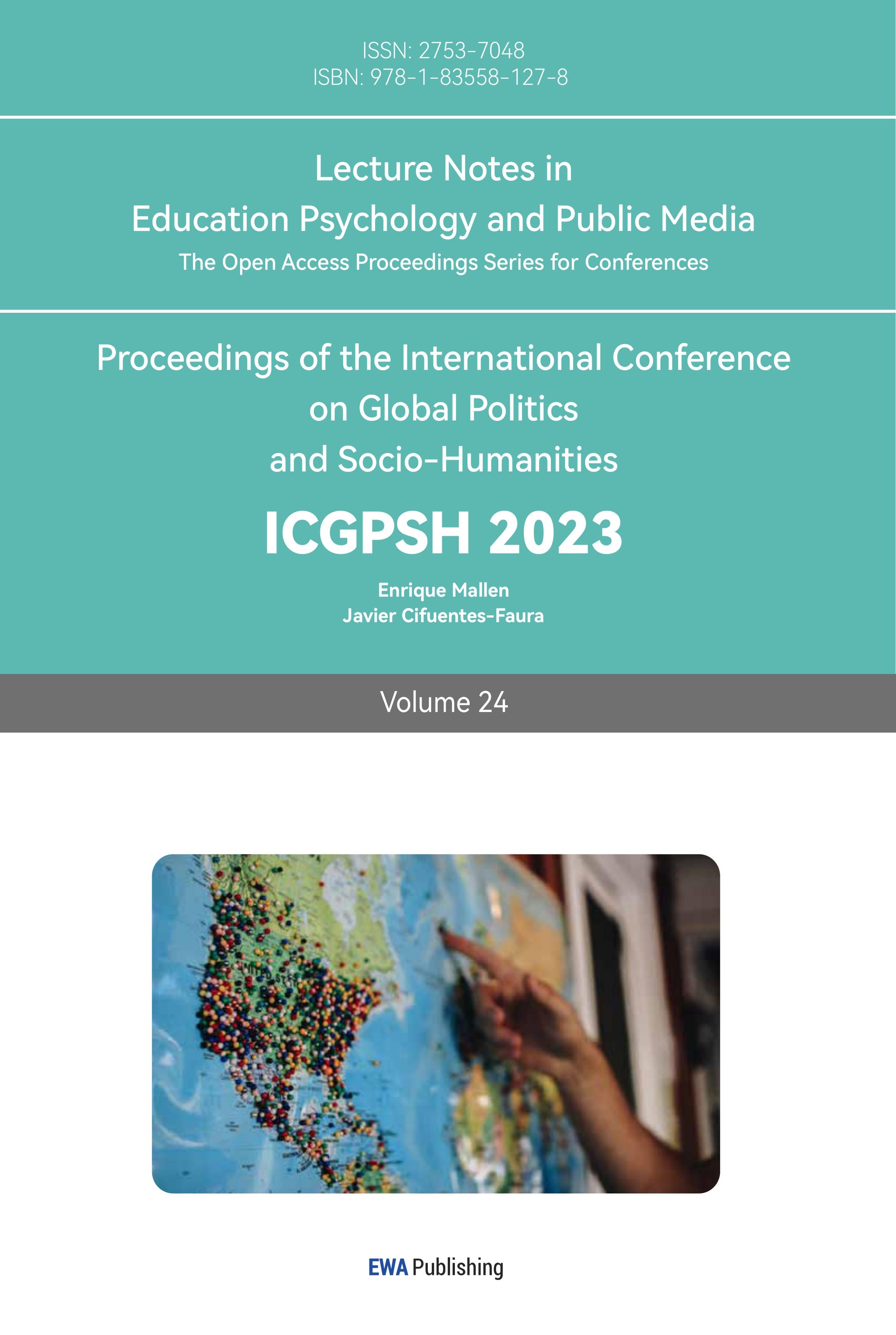References
[1]. Kelsen, H. (2004). Principles of international law. Clark, Nj Lawbook Exchange Ltd.
[2]. Craven, M. (1995). What’s in a name? The Former Yugoslav Republic of Macedonia and Issue of Statehood. Australian Year Book of lnternational Law. Retrieved from http://www5.austlii.edu.au/au/journals/AUYrBkIntLaw/1995/4.pdf
[3]. Rousseau, J.-J., Piauger, S., and Variety Artworks. (2016). Du contrat social. Paris ; Toulon: Soleil, Dl.
[4]. Engels, F. (2010). Der Ursprung der Familie, des Privateigenthums und des Staats : im Anschluß an Lewis H. Morgans Forschungen. Hamburg: Tredition.
[5]. Tilly, C., Evans, P. B., Dietrich Rueschemeyer, and Skocpol, T. (1985). War making and state making as organized crime. Cambridge: Cambridge University Press.
[6]. Victoria Tin-Bor Hui. (2005). War and state formation in ancient China and early modern Europe. New York Ny: Cambridge University Press.
[7]. Sun, G., Hu, Y., and Ren, J. (2008). Zheng zhi xue gai lun. Shanghai: Fu Dan University Press.
[8]. Fukuyama, F. (2015). Political order and political decay from the industrial revolution to the globalization of democracy. London Profile Books.
[9]. Skocpol, T. (1979). States and social revolutions: a comparative analysis of France, Russia, and China. Cambridge: Cambridge University Press.
[10]. Bi, J. (2022, January 6). Colonialism Has Left a Heavy Historical Burden on Africa. Retrieved August 27, 2023, from iwh.cssn.cn website: http://iwh.cssn.cn/marx/202201/t20220106_5387158.shtml
[11]. Huntington, S. P. (1996). The Clash of Civilizations and the Remaking of World Order. London: Penguin.
[12]. Anderson, B. (2006). Imagined Communities : Reflections on the Origin and Spread of Nationalism. London: Verso.
Cite this article
Nong,X. (2023). State Formation Patterns: China, European Countries, and Decolonized Countries. Lecture Notes in Education Psychology and Public Media,24,17-25.
Data availability
The datasets used and/or analyzed during the current study will be available from the authors upon reasonable request.
Disclaimer/Publisher's Note
The statements, opinions and data contained in all publications are solely those of the individual author(s) and contributor(s) and not of EWA Publishing and/or the editor(s). EWA Publishing and/or the editor(s) disclaim responsibility for any injury to people or property resulting from any ideas, methods, instructions or products referred to in the content.
About volume
Volume title: Proceedings of the International Conference on Global Politics and Socio-Humanities
© 2024 by the author(s). Licensee EWA Publishing, Oxford, UK. This article is an open access article distributed under the terms and
conditions of the Creative Commons Attribution (CC BY) license. Authors who
publish this series agree to the following terms:
1. Authors retain copyright and grant the series right of first publication with the work simultaneously licensed under a Creative Commons
Attribution License that allows others to share the work with an acknowledgment of the work's authorship and initial publication in this
series.
2. Authors are able to enter into separate, additional contractual arrangements for the non-exclusive distribution of the series's published
version of the work (e.g., post it to an institutional repository or publish it in a book), with an acknowledgment of its initial
publication in this series.
3. Authors are permitted and encouraged to post their work online (e.g., in institutional repositories or on their website) prior to and
during the submission process, as it can lead to productive exchanges, as well as earlier and greater citation of published work (See
Open access policy for details).
References
[1]. Kelsen, H. (2004). Principles of international law. Clark, Nj Lawbook Exchange Ltd.
[2]. Craven, M. (1995). What’s in a name? The Former Yugoslav Republic of Macedonia and Issue of Statehood. Australian Year Book of lnternational Law. Retrieved from http://www5.austlii.edu.au/au/journals/AUYrBkIntLaw/1995/4.pdf
[3]. Rousseau, J.-J., Piauger, S., and Variety Artworks. (2016). Du contrat social. Paris ; Toulon: Soleil, Dl.
[4]. Engels, F. (2010). Der Ursprung der Familie, des Privateigenthums und des Staats : im Anschluß an Lewis H. Morgans Forschungen. Hamburg: Tredition.
[5]. Tilly, C., Evans, P. B., Dietrich Rueschemeyer, and Skocpol, T. (1985). War making and state making as organized crime. Cambridge: Cambridge University Press.
[6]. Victoria Tin-Bor Hui. (2005). War and state formation in ancient China and early modern Europe. New York Ny: Cambridge University Press.
[7]. Sun, G., Hu, Y., and Ren, J. (2008). Zheng zhi xue gai lun. Shanghai: Fu Dan University Press.
[8]. Fukuyama, F. (2015). Political order and political decay from the industrial revolution to the globalization of democracy. London Profile Books.
[9]. Skocpol, T. (1979). States and social revolutions: a comparative analysis of France, Russia, and China. Cambridge: Cambridge University Press.
[10]. Bi, J. (2022, January 6). Colonialism Has Left a Heavy Historical Burden on Africa. Retrieved August 27, 2023, from iwh.cssn.cn website: http://iwh.cssn.cn/marx/202201/t20220106_5387158.shtml
[11]. Huntington, S. P. (1996). The Clash of Civilizations and the Remaking of World Order. London: Penguin.
[12]. Anderson, B. (2006). Imagined Communities : Reflections on the Origin and Spread of Nationalism. London: Verso.









